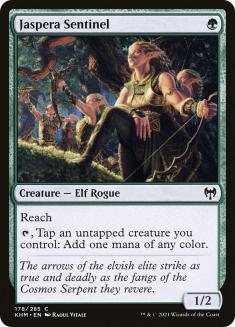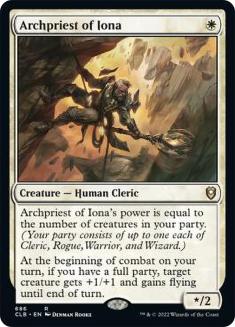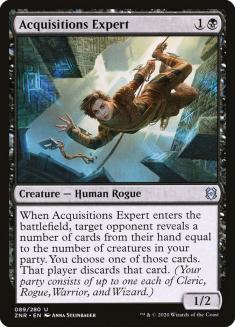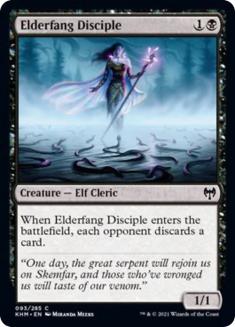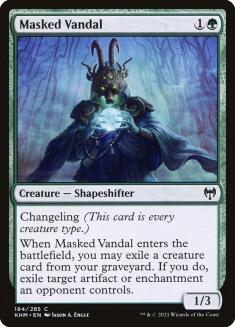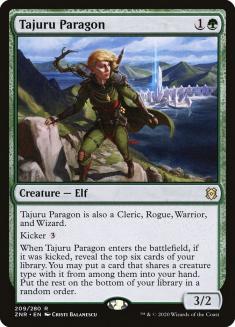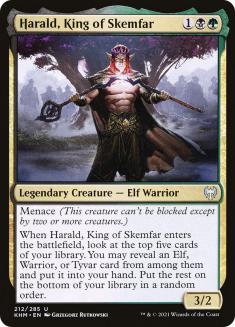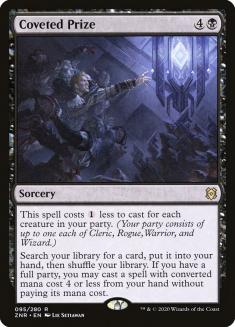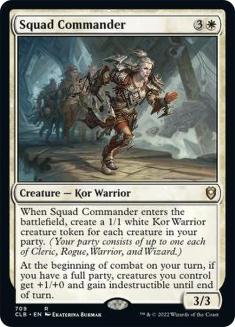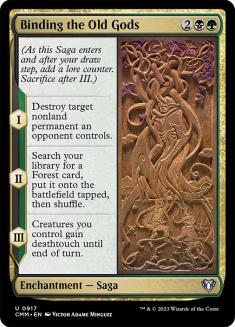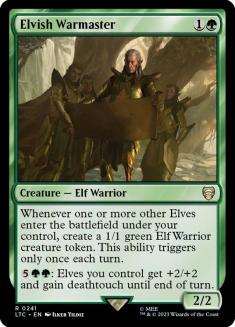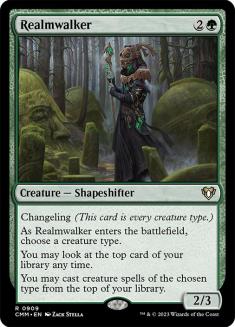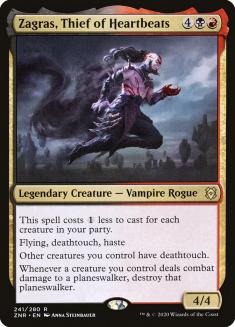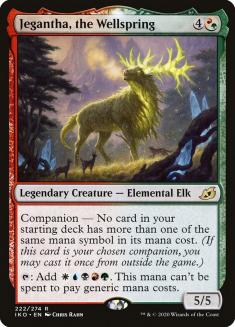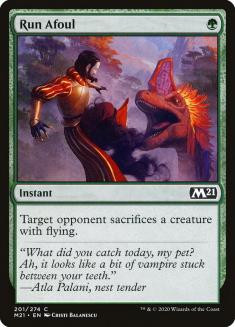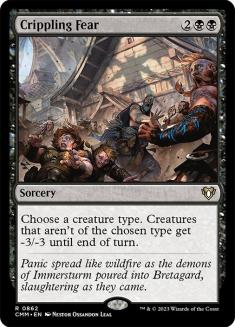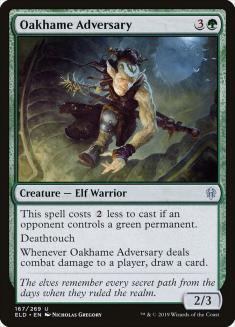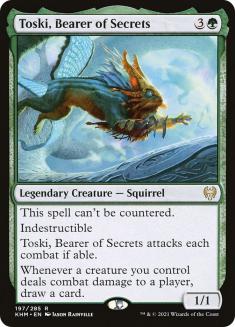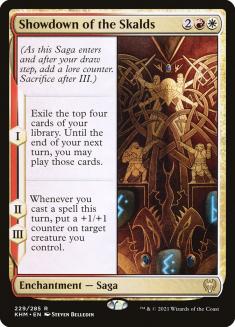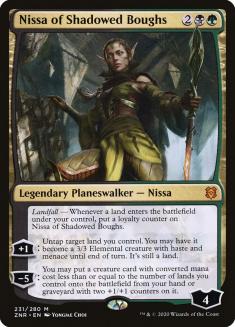The other day, I noticed that Elves were very good at tribal diversity among party classes and that Harald, King of Skemfar played nicely with other Warriors, and concluded that party synergies could be a good way to add power to an Elf deck or that Elves could be the best way to enable party synergies (depending on how you want to look at it). I’d looked at Bant Party before, but without a Triome, the mana was untenable. In Abzan, I’d get a Triome, and by sticking to mostly green I could make good use of Jaspera Sentinel for additional fixing.
I Tweeted the resulting deck:
I started with a large number of possible things to find with Coveted Prize, because I like to have options and to try more cards, but after playing with the deck is was clear that I only ever wanted to do one of to things: kill my opponent or destroy a card that was beating me, so I always wanted one of two cards —Squad Commander or Binding the Old Gods. Aaron Barich tried the deck and suggested Archpriest of Iona instead of the less necessary bullets to increase the speed and consistency of the deck and focus on quickly discounting Tazri, Beacon of Unity and Coveted Prize.
I had some concerns about that, since I’d previously kept white to a small late-game splash, but Archpriest of Iona was so much better than the other available one-drops that it made sense to stretch the mana a little and I agreed that lowering the curve was an improvement. That led to this:
Creatures (32)
- 3 Wildwood Tracker
- 2 Acquisitions Expert
- 4 Tazri, Beacon of Unity
- 4 Tajuru Paragon
- 4 Archpriest of Iona
- 1 Squad Commander
- 4 Masked Vandal
- 4 Harald, King of Skemfar
- 2 Elderfang Disciple
- 4 Jaspera Sentinel
Lands (23)
Spells (5)

The Maindeck
This is one of the best and most important cards in the deck. It has great types, you have a lot of other small creatures you don’t mind tapping for mana, and it fixes your tricky mana and allows you to generate blue or red to activate Tazri affordably in the mid- to late-game.
Tough on the mana and not a friend of Harald, but Archpriest of Iona is a great way to lower your curve and increase the power of the deck at the same time, which is a tough feat.
The deck is a little oversaturated with Warriors and I only need creatures that are either Elves or Warriors for Harald, but it’s the best aggressive one-drop available on rate. I’m not attached to it, which is why one was trimmed to make room for an extra land when I stretched my mana, and I could see cutting another for a second Squad Commander.
I could also see replacing these with Tajuru Blightblade. I’m pretty sure attacking for two is better than deathtouch, but a Rogue is much better for party diversity than a Warrior. If I made that change I’d probably also replace an Acquisitions Expert with an Elderfang Disciple to preserve balance among my Rogues and Clerics.
Acquisitions Expert is obviously stronger than Elderfang Disciple, but I think it’s important enough to balance my types and maximize my Harald hits that I split the difference to accomplish that. I might feel more conflicted about this if I didn’t have the other Acquisitions Experts in the sideboard for when I really care about the discard, but I think in the maindeck it’s just important to maximize the ability to cast a full-party Coveted Prize.
More essential pieces. Their flexibility at parties is what allows this deck to regularly assemble a full party, and both cards are actually good. Tajuru Paragon has an acceptable surface rate and the kicker ability is really nice late, and with so many cheap creatures, something usually dies pretty early. Masked Vandal has great targets against a huge portion of decks.
Harald, King of Skemfar can assemble a party, providing a body itself and reliably finding a type that I’m missing or a solid payoff. Harald is not just essential, it’s the reason the deck exists. For reference, with the current configuration of the deck, Harald is just under 94% to hit something when it enters the battlefield, which is pretty good. If you add or remove hits while sideboarding you change the maindeck, as each hit you add or remove changes the odds by around .8% for the first change, but if you cut multiple cards, it drops off at an increasing rate, while adding cards increases at a diminishing rate.
In a deck full of small creatures, Tazri, Beacon of Unity’s huge body is amazing at stopping opposing attackers, which allows this deck time to go wide and beat opposing creature decks with Squad Commander. Tazri’s a huge creature that you can usually cast on Turn 3, or very cheaply on Turn 4, and the activated ability is great here. Despite the fact that this is a legend, it’s something your opponent has to answer, and I wouldn’t cut any of them.
The allure of “What if I could cast any four-mana card for one mana?” has always tempted me, but I could never find a way to make it work. I identified early on that Squad Commander was usually the card I’d want, but it seemed like at that point, I should probably just play Squad Commander since it’s much better to draw if I don’t have a full party. This deck is so good at assembling a full party that drawing Coveted Prize is just better because then I only need to spend one mana for my Squad Commander, which means that it comes down with a full party a turn early, and I also get to play a deck that plays like it has five removal spells while only putting a single removal spell in my deck. This also adds a ton of strength to my sideboard, where I can afford to put any nice bullet I want without hurting my deck’s ability to form a party.
Sometimes my opponent dies the turn I cast Squad Commander, and they almost always die the following turn. Squad Commander turns this deck from a grindy assortment of value creatures into an explosive combo/aggro deck that just ends the game. There’s a lot of temptation to play a second copy, since it’s not particularly bad to draw, it would improve my ability to dig for it with Harald or Tazri, and it would give me a backup in case my opponent answered the first one, but so far it’s been rare that the first copy hasn’t been enough, so I’m focusing as much as possible on just making that happen. A second copy is absolutely the top of the list of cards I’m likely to want to add though.
There are a few things that Binding the Old Gods doesn’t answer, but it’s hard to find a card that covers you against more different things and both extra chapters are really valuable. I can’t really imagine cutting the first copy of Binding the Old Gods. Like with Squad Commander, it might be nice to have a second copy or another way to answer things, but for the most part, the deck plays short enough games that they’ll usually be determined one way or another after that, and I really just want to focus on keeping my curve low and consistent.
The Lands
Indatha Triome and twelve Abzan Pathways are automatic, so that leaves seven other lands to work with. I had Ketria Triome to find with Binding to make it easier to use Tazri, but sacrificed it to support Archpriest of Iona. A weird quirk of this manabase is that it has more sources of white than black despite the fact that this deck has thirteen black cards and nine white cards. This is because it’s important to be able to cast Archpriest on Turn 1, while Jaspera Sentinel and Indatha Triome can help cast black cards later.
Rather than playing basic lands, I’m playing Pathways that offer red or blue mana to make Tazri easier to activate. This makes the deck weak against Field of Ruin, so if you anticipate playing against that ever, you probably want to turn a green Pathway into a Forest (I choose Forest as the basic because I once drew all four Triomes and missed with Binding, so you might as well hedge against that). If you don’t anticipate that you’ll need a basic, it’s just better to support Tazri; my mix leans red because I have a Showdown of the Skalds in the sideboard. Depending on how important you think it is to cast Showdown, you might want to replace more, maybe even all of the blue Pathways with red Pathways.
What Didn’t Make It
Cards that didn’t quite make the cut, aside from different four-mana Coveted Prize targets:
When I tweeted this deck, I feel like two of the most common replies were “What about Elvish Warmaster?” and “How does this deck beat a Doomskar?” This deck can beat Doomskar because it doesn’t play Elvish Warmaster. Literally everything in this deck that costs more than one mana can provide some kind of material advantage, which means this deck can grind against control decks. Yes, sometimes they’ll overpower you with a Dream Trawler or something, but this isn’t the kind of deck that can’t beat a sweeper.
Elvish Warmaster doesn’t do what I’m trying to do. Because Harald and Tazri are so good, and Squad Commander’s my payoff, Warrior is the worst party type by a lot. And while I am trying to go wide, I do enough of that without maybe making a couple of tokens. My deck is always vulnerable to people killing my creatures because it disrupts my Coveted Prize, but I minimize that by playing creatures that my opponent can’t profitably kill. Elvish Warmaster would just let me get Stomped.
This does exactly what I want — it’s a hit for Harald and always adds to a party, and can help me assemble a party out of nowhere if the top of my deck’s cooperative. It might be worth playing one, but my guess has been that it likely won’t be worth it because the body’s just too small for three mana and I think it’ll usually be killed before you get anything out of it.
Zagras is a pretty awesome party payoff, and giving all my random small creatures deathtouch would be amazing, but it also costs red mana. If I made all my off color Pathways red, I could get seven lands that tap for red plus Jaspara Sentinel (and technically Jegantha), but I think it’s just too hard to cast.
The Sideboard
As always, Jegantha was an afterthought, but it is pretty awesome with Tazri. Given that I had Jegantha, I cut a few cards from the sideboard like Rankle, Master of Pranks; Tyvar Kell; and Garruk, Unleashed.
I mentioned Dream Trawler as a flyer this deck can’t answer with Binding the Old Gods. I’m playing Run Afoul over any other spot removal because the rate is so good and it’s so much better at answering both Dream Trawler and Goldspan Dragon than any other card. I’m looking for specialty cards in my sideboard because I don’t want to cut anything from my deck unless the card I’m adding is great. It’s possible that the third is excessive and I’d be better off with a single copy of another niche removal spell like Mythos of Nethroi or Soul Shatter, but I haven’t thought of other things I’d really want an answer for.
If the matchup is really grindy, it might not be as important to curve out as it is to attack your opponent’s hand, and I can replace some one-drops with more discard.
I was pretty excited about Skemfar Shadowsage as a tutor target that came up sometimes, but I think not quite enough to justify itself in the maindeck. I wanted it to burn my opponent out, but Squad Commander’s almost always a better way to do that. Cutting it left me without any way to gain life, and I think I want to be able to do that against aggro decks, so this is mostly in the sideboard as a lifegain spell. But, of course, once it’s in your deck you can always use it to kill the opponent instead.
This is the only card I’m playing that makes me give up Jegantha, but I figure it’s absolutely game-breaking against other small creatures, so it’d probably be worth it.
Oakhame Adversary is a pretty good Elf when it’s good.
Toski, Bearer of Secrets was great in theory, since I have a lot of creatures when I cast Coveted Prize and might want to draw cards, but I didn’t run into many decks with sweepers. Everyone else had creatures, so Squad Commander was always better. Against a control deck, Toski will usually be a better threat to Prize for than Squad Commander, so one’s still in the sideboard.
Showdown of the Skalds is like Toski, but a different way to grind.
Nissa of Shadowed Boughs offers yet another way to attack from a different angle. I don’t think this is a particularly good planeswalker, but I do think I can use Jegantha while it’s in my deck.
Playing the Deck
Playing Elf Party (Jegantha) is pretty straightforward. Cast your cheap creatures, attack, try not to trade creatures off whenever you can avoid it, assemble a full party, get Squad Commander, attack. The trickiest cards to play are Masked Vandal and Tajuru Paragon, since sometimes you don’t want to cast them because you want to wait to get more value out of them. Masked Vandal should be pretty easy to figure out how much value you’ll get out of holding it based on the matchup, and Tajuru Paragon is a matter of how flooded you are, but it’s often good to cast it on Turn 2 if you can.
The hardest part of playing this deck is the lands. Whether to play a Triome or a one-drop on a specific turn, which side and which order to play your Pathways, whether to hold a Triome to cycle — all your lands have options. You usually shouldn’t expect to have time to cycle a Triome. You should generally optimize for getting the most things on the battlefield over pushing damage if those things are ever in conflict; this deck isn’t really about winning by a single point but about having a big turn, so you want to play to that.
Don’t worry about getting blue or red mana, but you also won’t need double white or black very often, and you also might not care much about double green if most of your hand’s on the battlefield. If, given your hand, you can think of a reason you might need more white, black, or green mana, you should probably prioritize that, but if you can’t, you should take your first blue or red. Double black will only really matter if you need to cast Coveted Prize and a black creature or another Coveted Prize, but that’s much more likely than it is that you’ll want two white.
When it comes to sideboarding, less is more. If you’re not sure a sideboard card belongs, or would be an improvement over a card you’re cutting, leave it out. If you’re playing against a deck with a lot of removal, you might have to cut or trim Coveted Prize.
That’s it. A bit of an unusual deck, but it’s not too hard to play and does some really incredible explosive things while having a better long-game than you might expect. I’d recommend taking it for a spin.


